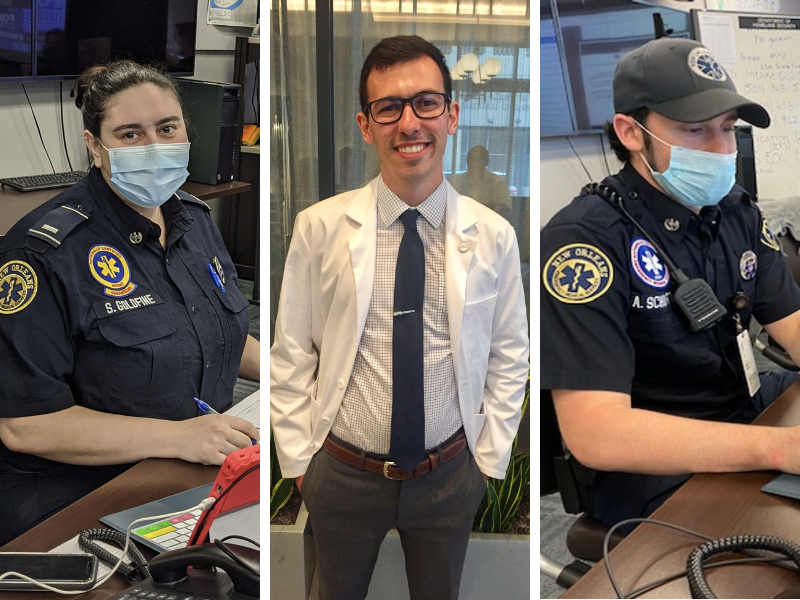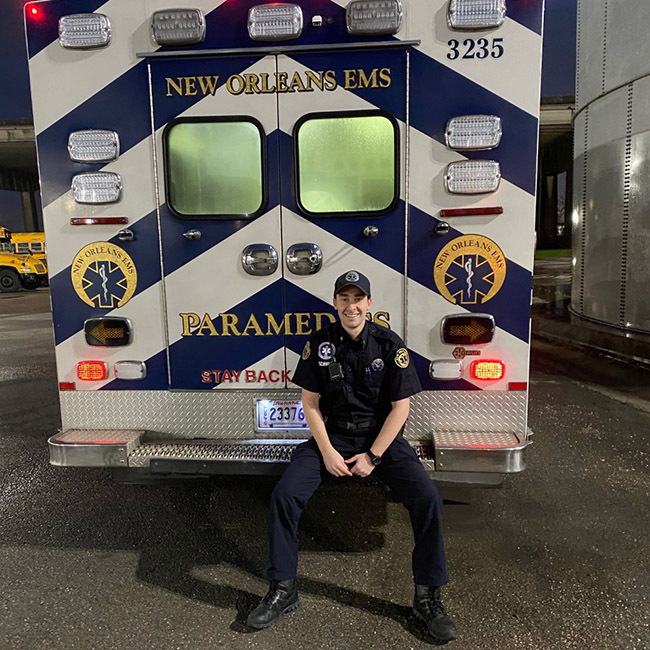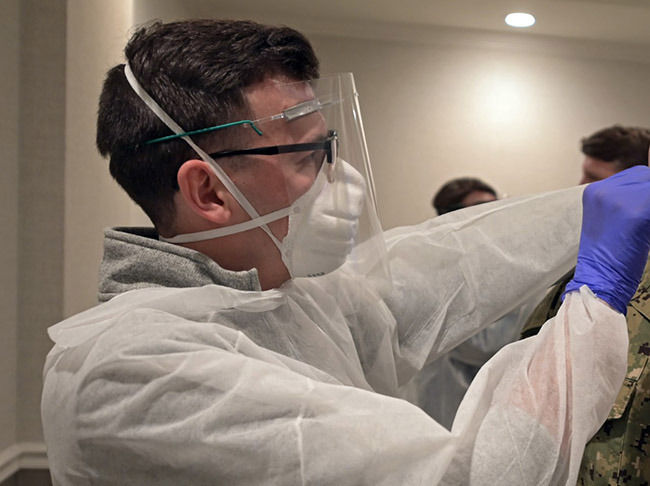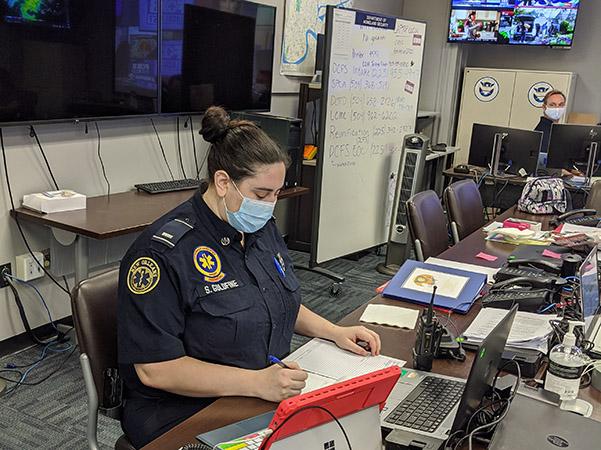Environmental Health Sciences students aid in emergency operations for Hurricane Laura

(Photos of Shayna Goldfine, Jake Hurwitz, and Alexander Schwartz)
Tulane University School of Public Health and Tropical Medicine provides an excellent, skills-based education, but there’s nothing like hands-on experience to bring that education to life. Three environmental health sciences students recently got that hands-on experience as they each played a unique role in the New Orleans response to Hurricane Laura, a Category 4 storm that threatened the city before making landfall in western Louisiana.
In addition to being a second year MD/MPH student, Jake Hurwitz is the planning section chief for the Medical Monitoring Station (MMS) at the Morial Convention Center, a role he serves on behalf of the Louisiana Department of Health (LDH), Office of Public Health. Since April, the MMS has operated as a COVID-19 treatment facility to relieve stress placed on hospitals, nursing homes, and other healthcare facilities across the entire state.
Hurwitz leads strategic planning for the facility’s operation. His job entails daily coordination between the facility and executive leadership at the LDH, as well other state agencies including the Governor’s Office of Homeland Security and Emergency Preparedness. In May, he was also tasked with leading the facility’s readiness for hurricane season.
Shayna Goldfine, a doctoral student in disaster management, works as a lieutenant in emergency operation for the New Orleans Emergency Medical Services (NOEMS), the primary provider of advanced life support emergency medical services, such as ambulances, rescue, and special response vehicles. She is also designated as the NOEMS liaison to the New Orleans Office of Homeland Security and Emergency Preparedness (NOHSEP).
Alexander Schwartz, who goes by Zander, is pursuing his MPH in disaster management and also serves as an emergency medical technician (EMT) with the New Orleans EMS Operations Staff. In fact, he trained under Goldfine.
As Hurricane Laura tracked toward Louisiana, Hurwitz was preparing for potential local impacts, readying the MMS facility to continue caring for New Orleans patients amidst stormy conditions. Goldfine’s work involved reviewing the special needs registry, a roster that helps city officials identify who might need extra help during an emergency. Both Hurwitz and Goldfine were engaged in ensuring that the health needs of the region - especially the most medically vulnerable residents - could be met before, during, and after the storm.
Meanwhile, Schwartz was working his regular ambulance shift. While the hurricane was tracking west of the city, EMS remained on alert with high water assets like rescue boats and high-water vehicles on standby in case the storm shifted back towards New Orleans. Schwartz, like other EMTs, was stationed at New Orleans Fire Department locations across the city in case they needed to hunker down when the storm hit.

(Photo of Alexander Schwartz in front of an ambulance)
When the hurricane eventually made landfall, the New Orleans region shifted from bracing for the storm to a posture of preparing to absorb evacuees from affected areas. In the aftermath of the storm’s flooding and destruction, nearly 12,000 evacuees poured into the city. The displaced were placed into 38 different hotels throughout the city.
“COVID-19 has greatly changed the landscape of hurricane response, particularly when it comes to sheltering evacuated individuals,” said Hurwitz. “Because of the need to maintain social distancing and other precautions, all evacuees here in New Orleans are being supported in non-congregate hotel shelters. While this is a protective measure to prevent COVID-19 spread, it brings new challenges: our health and medical resources must serve 38 different sites, rather than several large shelters. We also must work to bring testing to these individuals and provide appropriate support for those who must isolate or quarantine during their stay in a shelter.”

(Photo of Jake Hurwitz in personal protective equipment)
Once the immediate threat had passed, Goldfine was tasked with organizing FEMA surge ambulances, a cadre of emergency vehicles from all over the country sent by the Federal Emergency Management Association to provide assistance during a disaster. She directed all of the Orleans and some Jefferson Parish vehicles to meet in the parking lot of Audubon Zoo, and from there she dispatched them to evacuee hotels. EMTs like Schwartz were positioned at assigned hotels to answer questions from evacuees, assist with medical issues, and direct them to MMS if needed.

(Photo of Shayna Goldfine working at a desk at the New Orleans Homeland Security and Emergency Preparedness Office)
At the same time Hurwitz’s regional team was working to assess the health needs of these individuals and direct resources and partners into place to support this population. It was imperative that the MMS and other state resources remain available to meet any challenges brought by COVID-19.
Since then, Hurwitz has continued to coordinate the region’s health and medical support for evacuees. Alongside several colleagues at LDH and the New Orleans Health Department, he and his team are continuing to bring together the resources from federal, state, city, and local partners. Their response includes meeting immediate health needs and facilitating continued access to healthcare and mental health resources while in the region.
Goldfine has continued to work with the city and state health departments to make sure that EMS meet the needs of the population. She also handles transferring any EMS personnel to various locations as needed and relays critical information among NOEMS, NOHSEP, and City Hall.
A few weeks later, Hurricane Sally again threatened the city. During that storm Schwartz participated in the Emergency Operation Center (EOC) for that storm, training under Goldfine at the Emergency Operation Center in City Hall. The EOC is where all of the Public Safety partners for the City of New Orleans, state officials, and federal officials work during times of emergencies.
“I am thankful to have so many opportunities to learn about emergency management with hands-on and real-life experiences. I would like to thank New Orleans EMS for giving me the opportunity to be in the EOC during the last activation for Hurricane Sally. It was an experience I will never forget,” said Schwartz.
Hurricane Delta, currently in the Gulf, will likely bring more opportunities for these students to provide assistance and to get hands-on disaster management training.
